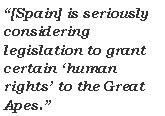Past Imperfect: Ancient Legal Codes and Future Transbeman Law - Precedents, Problems & Paradoxes
Professor Sam N. Lehman-Wilzig
Page 4 of 5
The Present
I do not mean to suggest that Ancient, Medieval and early Modern Legal precedents are the only source for our question. Indeed, there are several contemporary trends that could – and probably will – also provide a foundation  for future Transbeman law and jurisprudence. To cite but one very recent example: the Spanish legislature is seriously considering legislation to grant certain “human rights” to the Great Apes, and the draft law even talks about “the evolutionary and genetic similarities between humans and great apes”. This is a direct outcome of Prof. Peter Singer’s, “Animal Liberation”book and the “Great Ape Project” [1] that he founded. If this should happen, it might be a landmark in future Transbeman history, for it would have laid down the basic principle that non-humans may deserve human rights (many legal systems grant mammals certain “rights” such as painless slaughter etc. but those are not “human” rights).
for future Transbeman law and jurisprudence. To cite but one very recent example: the Spanish legislature is seriously considering legislation to grant certain “human rights” to the Great Apes, and the draft law even talks about “the evolutionary and genetic similarities between humans and great apes”. This is a direct outcome of Prof. Peter Singer’s, “Animal Liberation”book and the “Great Ape Project” [1] that he founded. If this should happen, it might be a landmark in future Transbeman history, for it would have laid down the basic principle that non-humans may deserve human rights (many legal systems grant mammals certain “rights” such as painless slaughter etc. but those are not “human” rights).
However, the Spanish case is very interesting from a different perspective. If we think about it, virtually the entire history of the struggle for full civil rights in the past has been a bottom-to-top phenomenon, i.e. the persecuted fighting the elite establishment for greater social recognition and expanded rights. In the contemporary Great Ape Project we find the reverse: a top-to-bottom movement of humans fighting for expanded rights for those “beneath” them on the totem pole.
What does this mean? In almost all the science fiction books and movies that I am aware of we see the same conventional pattern (e.g. Asimov’s “Bicentennial Man” [2] ): it is the non-human creature that is demanding human rights, exactly as the slaves of yesteryear. When we think of the future, the usual nightmare scenarios emerge: robots becoming more intelligent and ultimately war breaks out as they try to seize control, etc. (e.g. Karl Capek’s pioneering book on robots: RUR [3]). However, if the top-to-bottom approach becomes dominant, then I believe that that would preempt any such “warfare”, because the granting of rights to Transbemans would come from humans themselves (even if struggling politically against each other) and not through any type of Spartacus uprising. [Without digressing too much, it can be noted that the Deep Green movement viewing Mother Earth as a moral Being in its own right and having fundamental rights, is another example of the contemporary “top-to-bottom” approach.]

Image 3: Contemporary Trends
We should also note that computer hardware research has recently had some initial success with biological chips, i.e. we may well have a situation in the future where the “non-biological body” argument against giving rights to robots may no longer be relevant because they could be constructed of organic material! Finally, as Kurzweil cogently notes, humans themselves could “enhance” their powers by “interfacing” with inorganic computers – a situation that would further blur the line between organic and inorganic beings – and the rights accruing to each.

Image 4: Paradox, Problem & Preferred Policy
Footnotes
1. The Great Ape Project – an international group founded to work for the global removal of non-human great apes from the category of mere property, and for their immediate protection through the implementation of basic legal principles designed to provide these amazing creatures with the right to life, the freedom of liberty and protection from torture.
http://www.greatapeproject.org/ August 3, 2007 4:40PM EST
2. Bicentennial Man – a novel by writer, Isaac Asimov. The "Bicentennial Man" of the title is a robot, who acquires the name "Andrew Martin" from the family which he valets for. He discovers a talent for woodworking and craftsmanship, gets himself declared legally human (fortunately his original owners are a family of political lawyers), and gradually becomes medically human as well; finally he is allowed to die a "natural" death, two hundred years after his construction.
http://www.nicholaswhyte.info/sf/tbm.htm August 3, 2007 5:29PM EST
3. RUR – (Rossum's Universal Robots) is a science fiction play by Karel Čapek. It premiered in 1921 and is famous for having introduced and popularized the term robot.
http://en.wikipedia.org/wiki/R.U.R._(Rossum's_Universal_Robots) August 3, 2007 5:33PM EST
1 2 3 4 5 next page>